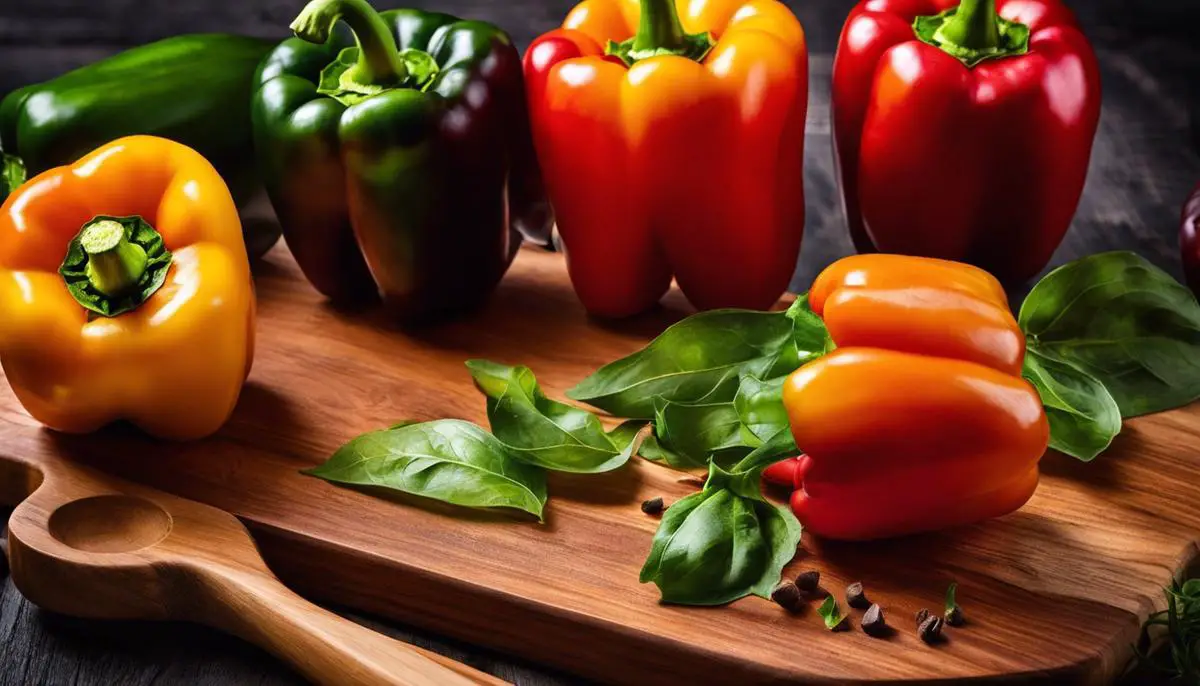Sweet Bell Peppers, with their splash of vibrant colors and taste that teeters on the perfect balance between sweet and tangy, can truly be the shining star of your vegetable garden. As delightful as they are to the palate, these dynamic fruits can also add a dash of nature’s paint to your green patch. Whether you’re a novice gardener ready to dip your thumb into some soil or an experienced horticulturist looking forward to grow your first bell peppers, understanding these colorful wonders through their origin, varieties, climate preferences, and life cycle can set the stage for a successful gardening endeavor. Armed with the right prep work, a bit of patience, and a tad of maintenance, you can turn from bell pepper admirer to bell pepper grower. So let’s dig in and embrace the world of sweet bell peppers together.
Understanding Sweet Bell Peppers
Pepper Power: A Quick Guide to Sweet Bell Peppers
Reader Poll: What online courses would interest you?
Imagine a vegetable that can pack a powerful punch of vitamin C, range in colors from vibrant reds to deep purples, and provide a sweet yet crisp bite. Well, don’t just imagine it… meet the sweet bell pepper!
Understanding the Colors of Sweet Bell Peppers
First thing’s first, many wonder about the different colors that bell peppers can come in. Green, yellow, orange, and red are the most common colors seen in your local grocery stores. The interesting thing is, all these variations come from the same plant, just at different stages of ripening!
Green peppers are harvested earlier, and as they mature on the plant, they change colors. Red peppers are fully ripe, and therefore, they have a sweeter taste compared to their younger, green counterparts. The colors in-between, like yellow and orange, simply represent different stages in the ripening process!
Subscribe to our newsletter!
Caring for Bell Pepper Plants
Growing your own sweet bell peppers can be an exciting and rewarding venture. They love lots of sunlight and prefer warm temperatures, ideally between 70 and 85 degrees Fahrenheit. Providing them with properly drained soil and consistent watering will reward you with a plethora of crunchy, sweet peppers in a few months!
Cooking with Sweet Bell Peppers
Sweet bell peppers are remarkably versatile in the kitchen. Their natural sweetness and juicy crunch can complement a wide range of dishes. Do you need some rainbow colors in your stir-fry? Add some bell peppers for an instant splash of vibrance. Are you looking to up the nutrient game in your pasta? Toss in some thinly sliced bell peppers. For a simple yet scrumptious side, consider a bell pepper salad with a dressing of your choice!
Additionally, sweet bell peppers are ideal for grilling and roasting. Their robust skin can withstand high temperatures, allowing the outer layer to char slightly, which deepens their flavor.
Health Benefits of Sweet Bell Peppers
Whether in your garden or on your plate, sweet bell peppers offer more than just visual appeal and a delightful crunch. They are incredibly nutritious! A single cup of chopped red bell pepper contains nearly three times the vitamin C of an orange. They are also a decent source of vitamin B6 and folate, contributing positively to nerve function and heart health.
In the world of vegetables, sweet bell peppers undeniably shine with their color, flavor, and nutritional benefits. Whether you’re growing them in your backyard or introducing them into your menu, it’s about time this delightful veggie gets the recognition that it so rightly deserves. Enjoy!
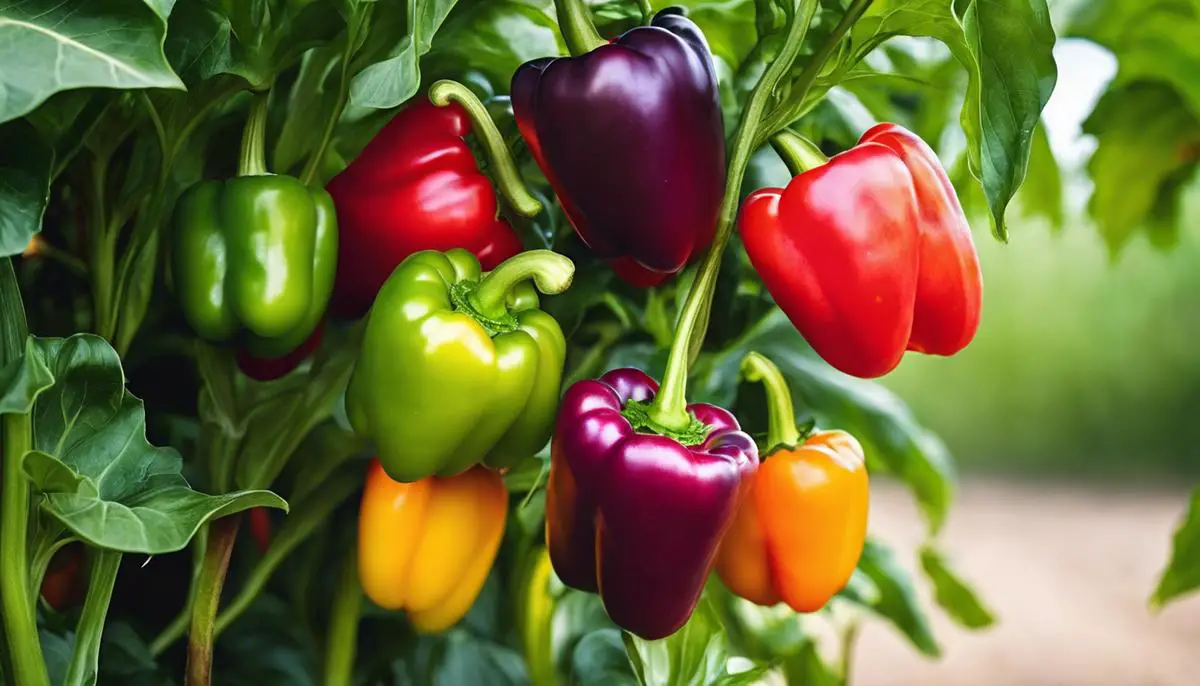
Preparing the Proper Environment
Forming the Ideal Growing Space for Sweet Bell Peppers
When cultivating the vibrant sweet bell pepper, it’s vital to understand that the key to a bountiful harvest lies in the growing environment. Providing the perfect habitat, with balanced light, ideal temperatures, and the correct soil formulation, will ensure your peppers grow robustly. Let’s delve into the specifics of setting up this environment.
Light: Sun-Lit Love for Sweet Bell Peppers
Sweet bell peppers relish in sunlight. Harvesting this colorful crop is a game of patience coupled with attentive positioning. Ideally, pepper plants should enjoy six to eight hours of daily sunlight. If you’re growing peppers in an indoor home garden, placing them near south-facing windows works like a charm. Alternatively, you can invest in a full-spectrum grow light that mimics natural sunlight if sunlight is scarce in your location.
Temperature: The Sweet Spot for Sweeter Peppers
Sweet bell peppers thrive in warmth, with the ideal temperature range lying between 70-85 degrees Fahrenheit. Peppers are frost-sensitive; any exposure to temperatures below 60 degrees can hinder growth and fruiting. For this reason, growing sweet bell peppers in summers is a popular practice. For winter cultivation, indoor gardening with regulated temperatures will ensure your bell pepper plants continue to thrive.
Soil: The Foundation of Flourishing Peppers
The right soil is a magic mixture your bell pepper plants can’t do without. A well-drained, loamy to sandy soil with a pH between 6.2 and 7.0 is the perfect fit for sweet bell peppers. Adding compost or manure is recommended to boost nutrient content. Ensure proper drainage to avoid waterlogging, as this can harm the plant’s roots and adversely affect growth.
Watering Habits: Hydrate with Care
Just as striking the ideal balance between sunlight and shade is necessary, so too is providing the perfect amount of water. The soil should remain moist for most of the growing period but not waterlogged. Missing the mark on watering can cause blossom end rot, where the fruit’s base blackens – not a desirable situation! Plan to water the plants one to two inches per week, and more frequently during dry, hot conditions. To retain soil moisture, mulch around the base of the plants.
To conclude, these easy-to-follow guidelines can make the difference between growing average sweet bell peppers and cultivating a vibrant, lush, flavorful batch. Mulching, moderate watering, sunlit conditions, warm temperatures, and nutrient-rich soil are the quintessential elements to keep in mind. Happy gardening!
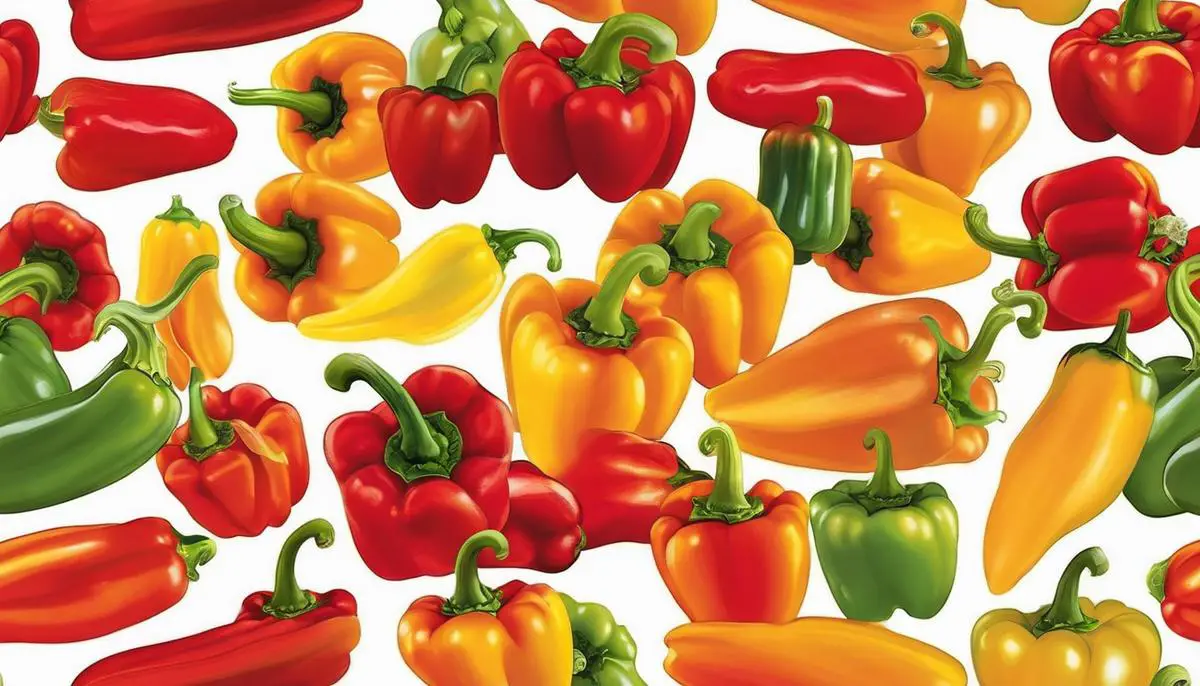
Planting and Caring for Sweet Bell Peppers
Introduction
Embracing the world of vegetable cultivation can be quite rewarding, especially when you get to produce juicy sweet bell peppers. Cultivators understand the difference that right growing habits can create, turning a tiny seed into an organically-grown masterpiece. So, let’s dive right in, and learn how to plant sweet bell peppers successfully starting from sowing seeds to ultimate harvesting.
Selecting the Right Seeds
Sweet bell peppers come in an array of different varieties. Each variant has a specific growth requirement, flavor, and mature color. It is essential to choose the variant according to personal preference and growing conditions.
Seeds to Seedlings
For successful growth, sow the pepper seeds indoors approximately 8-10 weeks before the last spring frost. Plant the seeds 1/4 inch deep in a well-drained, light-textured seed-starting mix. Maintain the temperature within a range of 70-80°F. Once the seedlings have grown, transplant them to 3-4 inch pots until ready for outdoor transplanting.
Transplanting
Once the risk of frost has passed, and soil temperature has consistently reached 65°F, sweet bell peppers are ready for transplanting. Hardening off the seedlings can help them adjust to outdoor conditions. For optimal growth, ensure each plant has about 18-24 inches of space around, with rows spaced about 3 feet apart.
Nourishing the Plant
Sweet bells pepper plants thrive in a rich nutrient environment. An application of balanced, organic fertilizer during the planting ensures a robust start. Further, side dressing the plants with compost or well-decomposed manure can boost nutrient availability during the flowering stage, initiating a healthy fruit-set.
Pollination
The flowering stage paves the way for pollination, a critical process leading to fruit setting. Sweet bell pepper plants possess perfect flowers, containing both male and female parts, making them self-fertilizing. However, encouraging beneficial insects or using soft brushes to assist pollination can ensure all flowers set fruit.
Pest Management
The plant’s health merits constant monitoring to avoid insect attack and disease. Aphids, cutworms, flea beetles, and pepper maggots are common pests affecting these plants. Organic or chemical pesticides selectively used can help keep the pests at bay. As for disease, implementing a healthy crop rotation can prevent soil-borne diseases.
Harvesting
Sweet bell peppers typically take about 60-90 days from transplanting to mature depending on the variety. Peppers can be harvested at any stage, but for the sweetest flavor, allow them to reach full maturity, characterized by their bright, vibrant color.
In conclusion, cultivating sweet bell peppers is a process relished by many gardening enthusiasts. Ensuring proper growing conditions and practices can result in a bountiful harvest, enough to spice up any culinary venture. Happy cultivating!
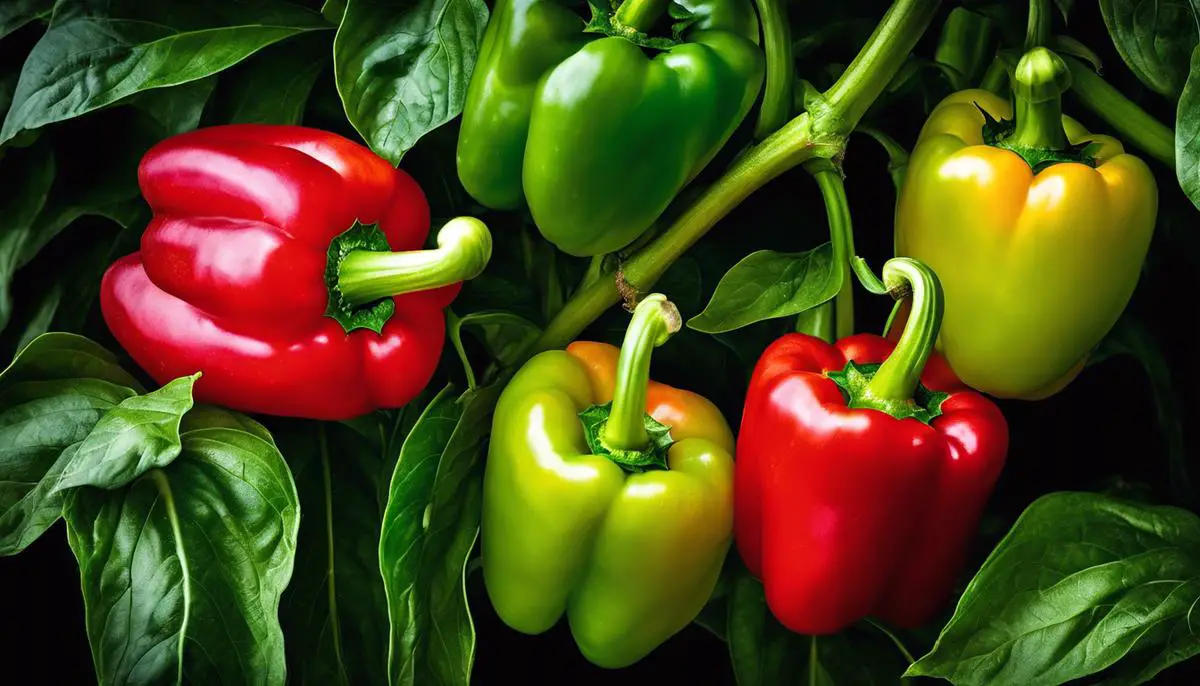
Harvesting and Use of Preserved Bell Peppers
Once you’ve nurtured your sweet bell pepper plants and they have successfully flowered, the next crucial step calls– Harvesting. Knowing when and how to harvest bell peppers is not as tricky as it might seem. With a keen eye and a gentle touch, you can enjoy fresh, homegrown peppers right from your own garden!
When to harvest generally depends on the color that you want your sweet bell peppers to be. They start by turning a deep green, which is the earliest sign for ripening. It typically takes about 60-90 days for peppers to reach this stage. If you love a crisp, slightly bitter taste, then green sweet bell peppers may be your preferred snack.
However, if you allow the bell peppers to remain on the plant a little longer, they begin to change color. Shades of yellow or orange may appear, followed by red, purple or chocolate, depending on the variety. This process can take an extra 2 to 3 weeks. The longer they stay on the vine, the sweeter they become.
While you may be tempted to just yank off your ripe bell peppers, the best harvesting method is to use a sharp pair of garden shears or a knife. Cut the stem about an inch or two from the top of the fruit, taking care not to damage your plant.
Now that you have a bounty of fresh sweet bell peppers, what about preserving them? Fear not!
One of the easiest ways to preserve your bell peppers is to freeze them. Start by washing the peppers and patting them dry. Next, remove the seeds and slice the peppers into strips or dice them, according to your preference. Spread the pieces out on a baking sheet and pop them into the freezer for a few hours. Once they are frozen, transfer them into a freezer bag or container. They can be stored this way for about a year, ready to be used in soups, stews, or stir-fry recipes.
Can you imagine the satisfaction of adding homegrown, preserved bell peppers to your meals in the heart of winter? Now that’s vegetable gardening at its finest!
Regardless of what color, shape or size sweet bell peppers you choose to grow, remember: good things come to those who wait. Patience is a true virtue in the world of gardening. Embrace the journey, the learning, and most importantly, the succulent rewards of your labor. Enjoy your venture into pepper cultivation!
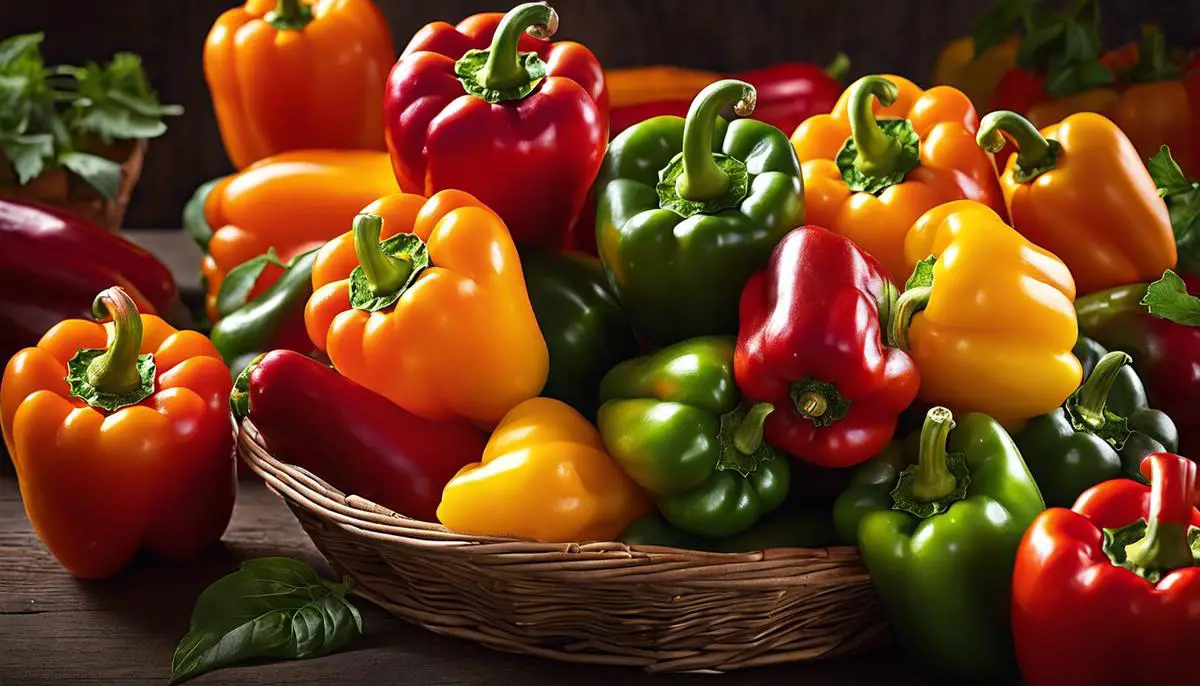
Harvesting your very own bell peppers, grown with love and patience, can be an exhilarating experience, and seeing them serve their purpose even more so. Whether you roast them to a char, stuff them with your favorite filling, slice them into your salad, or preserve them as tantalizing jam, every bite will remind you of the journey – from understanding these vibrant vegetables to reaping the fruits of your efforts. Remember, each sweet bell pepper brings with it a burst of color, flavor, and the promise of a homegrown feast. Plant, nurture, harvest, and savor – it’s a rewarding cycle that connects you to nature and feeds both your body and soul.

